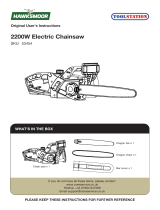POWEG10100 EN
Copyright © 2021 VARO P a g e | 6 www.varo.com
5.4 Power tool use and care
▪ Do not expect the power tool to do more than it can. Use the correct power tool for what
you want to do. A power tool will achieve better results and be safer if used in the context
for which it was designed.
▪ Do not use the power tool if the switch cannot turn it on and off. A power tool with a broken
switch is dangerous and must be repaired.
▪ Disconnect the plug from the power source before making adjustments, changing
accessories, or storing power tools. Such preventive safety measures reduce the risk of
starting the power tool accidentally.
▪ Store power tools, when not in use, out of the reach of children and do not allow people
who are not familiar with the power tool or these instructions to operate it. Power tools are
potentially dangerous in the hands of untrained users.
▪ Maintain power tools. Check for misalignment or jammed moving parts, breakages or any
other feature that might affect the operation of the power tool. If it is damaged, the power
tool must be repaired. Many accidents are caused by using poorly maintained power tools.
▪ Keep cutting tools sharp and clean. Properly maintained cutting tools with sharp cutting
edges are less likely to jam and are easier to control.
▪ Use the power tool, accessories and cutting tools, etc., in accordance with these
instructions and in the manner intended for the particular type of power tool, taking into
account the working conditions and the work which needs to be done. Using a power tool
in ways for which it was not intended can lead to potentially hazardous situations.
5.5 Service
▪ Your power tool should be serviced by a qualified specialist using only standard spare
parts. This will ensure that it meets the required safety standards.
6 CHAIN SAW SAFETY WARNINGS
▪ Keep all parts of the body away from the saw chain when the chain saw is operating.
Before you start the chain saw, make sure the saw chain is not contacting anything. A
moment of inattention while operating chain saws may cause entanglement of your
clothing or body with the saw chain.
▪ Always hold the chain saw with your right hand on the rear handle and your left hand on
the front handle. Holding the chain saw with a reversed hand configuration increases the
risk of personal injury and should never be done.
▪ Wear safety glasses and hearing protection. Further protective equipment for head,
hands, legs and feet is recommended. Adequate protective clothing will reduce personal
injury by flying debris or accidental contact with the saw chain.
▪ Do not operate a chain saw in a tree. Operation of a chain saw while up in a tree may
result in personal injury.
▪ Always keep proper footing and operate the chain saw only when standing on fixed,
secure and level surface. Slippery or unstable surfaces such as ladders may cause a loss
of balance or control of the chain saw.
▪ When cutting a limb that is under tension be alert for spring back. When the tension in the
wood fibres is released the spring loaded limb may strike the operator and/or throw the
chain saw out of control.
▪ Use extreme caution when cutting brush and saplings. The slender material may catch the
saw chain and be whipped toward you or pull you off balance.
▪ Carry the chain saw by the front handle with the chain saw switched off and away from
your body. When transporting or storing the chain saw always fit the guide bar cover.
Proper handling of the chain saw will reduce the likelihood of accidental contact with the
moving saw chain.
▪ Follow instructions for lubricating, chain tensioning and changing accessories. Improperly
tensioned or lubricated chain may either break or increase the chance for kickback.
▪ Keep handles dry, clean, and free from oil and grease. Greasy, oily handles are slippery
causing loss of control.















